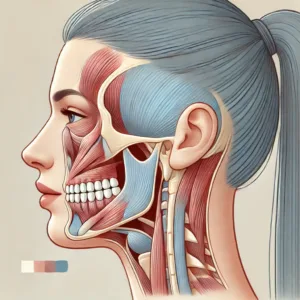Can TMJ cause migraines? Understanding the Connection and Treatment Options
Table of Contents
Can TMJ Cause Migraines? Understanding the Connection
When dealing with persistent migraines, it’s important to explore all potential causes, including those that might not be immediately obvious. One such connection that many people overlook is the relationship between temporomandibular joint disorders (TMD) or temporomandibular joint (TMJ) dysfunction and migraines. This post will delve into how TMD or TMJ issues can contribute to migraines, the underlying mechanisms involved, and what you can do if you suspect this might be affecting you.
What is TMJ Disorder?
To understand the link between TMD/TMJ and migraines, it’s crucial to first grasp what these terms mean. The temporomandibular joint (TMJ) is the hinge connecting your jawbone to your skull. Temporomandibular disorders (TMD) refer to a range of conditions that affect this joint and the surrounding muscles. Symptoms of TMD can include:
- Jaw pain or tenderness
- Clicking or popping sounds when moving the jaw
- Difficulty opening or closing the mouth
- Headaches
TMJ disorders are often grouped under TMD, but not all TMJ problems are classified as TMD.
How Can TMJ disorder Lead to Migraines?
Migraines are complex neurological events often characterized by severe, throbbing pain, usually on one side of the head, accompanied by symptoms such as nausea, sensitivity to light, and sound. The connection between TMD/TMJ and migraines can be understood through several key mechanisms:
- Muscle Tension and Strain: TMD can cause significant strain on the muscles surrounding the jaw, neck, and head. When these muscles are tense or strained, they can lead to tension headaches and potentially trigger migraines. The muscles involved include the masseter and temporalis, which are crucial for jaw movement and can become overactive or fatigued in the presence of TMD.
- Nerve Irritation: The TMJ is located close to several major nerves, including the trigeminal nerve, which is heavily involved in headache pain. Irritation or inflammation of the TMJ can affect these nerves, potentially contributing to migraine pain.
- Poor Posture: TMD often leads to poor posture as individuals adjust their head and neck position to alleviate jaw pain. This poor posture can contribute to tension in the neck and shoulders, which can, in turn, trigger migraines.
- Bruxism (Teeth Grinding): Many individuals with TMD suffer from bruxism, or the grinding of teeth, which can exacerbate jaw pain and contribute to migraine onset. The pressure from teeth grinding can strain the jaw muscles and affect the alignment of the TMJ.
Diagnosing the Connection
If you suspect that your migraines might be related to TMD or TMJ issues, it’s essential to consult with healthcare professionals who can accurately diagnose and address these conditions. Here’s what you can expect during the diagnostic process:
- Medical History Review: Your doctor will review your symptoms, including the frequency and intensity of your migraines and any signs of jaw pain or dysfunction.
- Physical Examination: A physical examination of the jaw, including checking for tenderness and assessing jaw movement, will help in diagnosing TMD.
- Imaging Tests: In some cases, imaging tests such as X-rays, CT scans, or MRIs may be required to evaluate the condition of the TMJ and surrounding structures.
Treatment Options for TMD-Related Migraines
If your migraines are linked to TMD or TMJ issues, treating the underlying jaw disorder may alleviate or reduce your migraine symptoms. Treatment options include:
- Lifestyle and Home Remedies: Applying heat or cold packs to the jaw, practicing relaxation techniques, and avoiding excessive jaw movements can help manage TMD symptoms.
- Dental Appliances: Custom-made mouthguards or splints can help alleviate bruxism and reduce stress on the TMJ.
- Physical Therapy: Specific exercises and stretches can improve jaw function, reduce muscle tension, and correct posture issues.
- Medications: Over-the-counter pain relievers or muscle relaxants may help manage TMD symptoms. For migraines, medications prescribed by your healthcare provider may be necessary.
- Professional Treatments: In severe cases, treatments such as injections or surgical options may be considered.
Preventing TMD-Related Migraines
Preventing migraines that stem from TMD involves both managing the underlying jaw disorder and adopting habits that reduce the risk of migraine triggers. Here are some strategies:
- Manage Stress: Stress is a common trigger for both TMD and migraines. Techniques such as mindfulness, yoga, and regular physical exercise can help manage stress levels.
- Avoid Jaw Strain: Be mindful of activities that put excessive strain on your jaw, such as chewing gum or eating hard foods.
- Regular Dental Checkups: Regular visits to your dentist can help monitor and address any potential issues with your TMJ and bite alignment.
Conclusion
The connection between TMD/TMJ disorders and migraines is a significant and often overlooked aspect of migraine management. By understanding how TMJ issues can contribute to migraine pain and exploring effective treatment and prevention strategies, you can take proactive steps towards alleviating your symptoms. If you suspect that your migraines might be linked to TMD, consult with a healthcare professional to explore potential solutions and improve your overall quality of life.
If you found this information helpful, share it with others who might benefit from understanding the connection between TMD/TMJ and migraines. For more tips and insights on managing migraines and related conditions, stay tuned to our blog.
By focusing on clear, informative content and addressing common concerns with authoritative yet accessible language, this blog post is designed to rank well in search results and provide valuable information to readers.













Post Comment